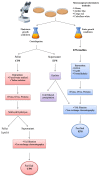Exopolysaccharides from Marine and Marine Extremophilic Bacteria: Structures, Properties, Ecological Roles and Applications
- PMID: 29461505
- PMCID: PMC5852497
- DOI: 10.3390/md16020069
Exopolysaccharides from Marine and Marine Extremophilic Bacteria: Structures, Properties, Ecological Roles and Applications
Abstract
The marine environment is the largest aquatic ecosystem on Earth and it harbours microorganisms responsible for more than 50% of total biomass of prokaryotes in the world. All these microorganisms produce extracellular polymers that constitute a substantial part of the dissolved organic carbon, often in the form of exopolysaccharides (EPS). In addition, the production of these polymers is often correlated to the establishment of the biofilm growth mode, during which they are important matrix components. Their functions include adhesion and colonization of surfaces, protection of the bacterial cells and support for biochemical interactions between the bacteria and the surrounding environment. The aim of this review is to present a summary of the status of the research about the structures of exopolysaccharides from marine bacteria, including capsular, medium released and biofilm embedded polysaccharides. Moreover, ecological roles of these polymers, especially for those isolated from extreme ecological niches (deep-sea hydrothermal vents, polar regions, hypersaline ponds, etc.), are reported. Finally, relationships between the structure and the function of the exopolysaccharides are discussed.
Keywords: EPS; GC-MS; NMR; capsular polysaccharide; chemical characterization; exopolysaccharides; extremophile; marine; purification; structure/activity relationship.
Conflict of interest statement
The authors declare no conflict of interest.
Figures






References
-
- Barsett H., Ebringerovà A., Harding S.E., Heinze T., Hromàdkovà Z., Muzzarelli C., Muzzarelli R.A.A., Paulsen B.S., El Seoud S.A. In: Polysaccharides I. Structure, Characterisation and Use. Heinze T., editor. Springer; Berlin, Germany: 2005.
-
- Ding Y.X., Chin W.C., Rodriguez A., Hung C.C., Santschi P.H., Verdugo P. Amphiphilic exopolymers from Sagittula stellata induce DOM self-assembly and formation of marine microgels. Mar. Chem. 2008;112:11–19. doi: 10.1016/j.marchem.2008.05.003. - DOI
Publication types
MeSH terms
Substances
LinkOut - more resources
Full Text Sources
Other Literature Sources
Molecular Biology Databases
Miscellaneous

